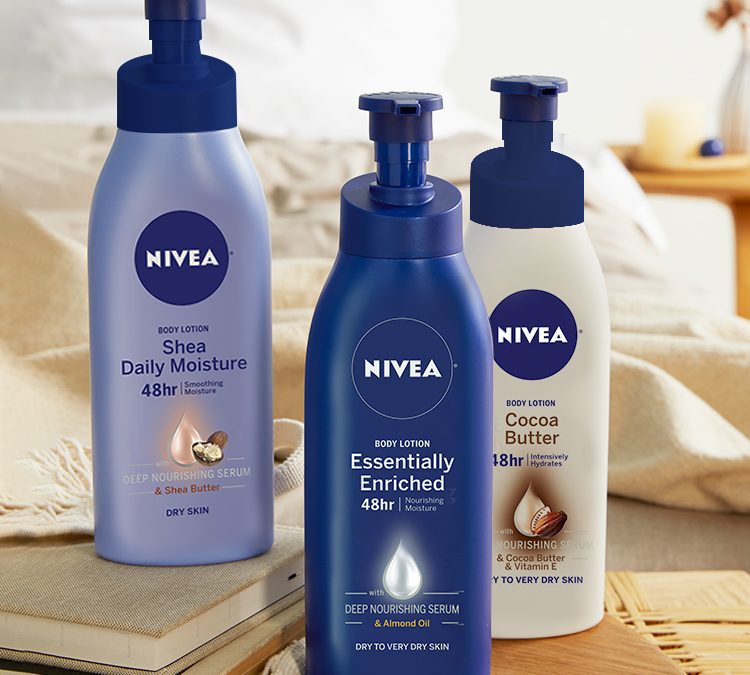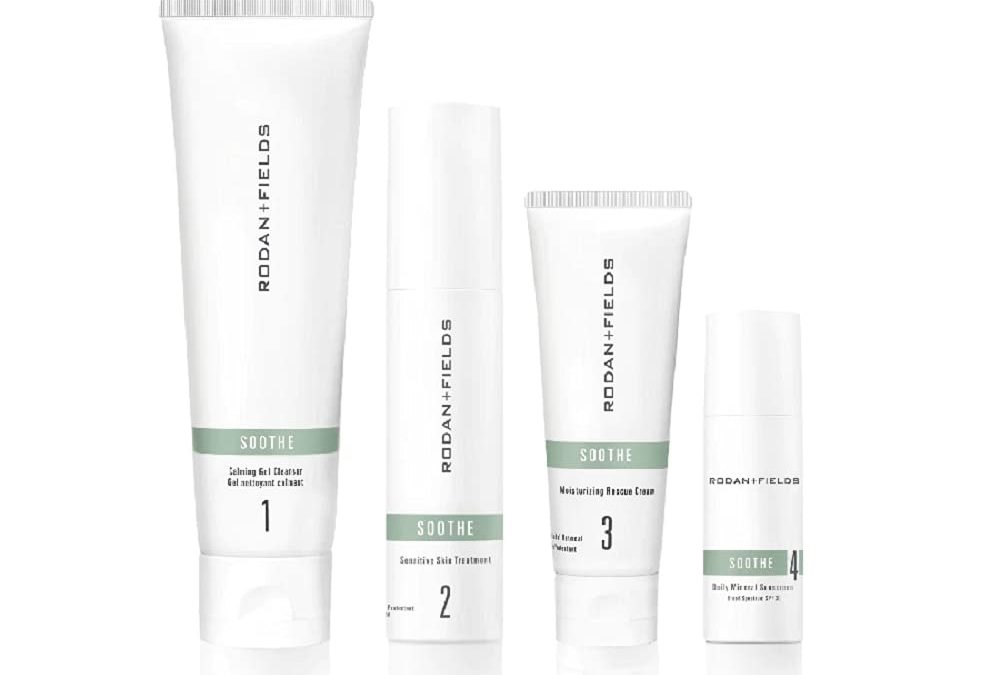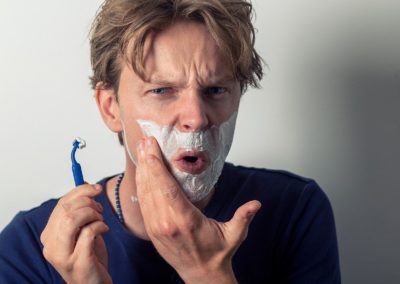How To Shave Sensitive Skin

written by nail expert Jess Rowley
How To Shave Sensitive Skin
Shaving isn’t as easy as it may seem and unfortunately, there are always risks involved and nasty side effects if you don’t do it the right way.
Fortunately, it’s easy to learn the right way and find out the info you need to help with shaving your sensitive skin as we’ve compiled it all here to help you out.
Shaving Foam Or Shaving Gel?
The first thing you should consider for sensitive skin is whether to use shaving foam or shaving gel. Both of these shaving products are designed to help razors smoothly cut hair close to the skin, but their formulation can differ vastly.
Shaving foams typically contain alcohol, synthetic fragrances, and harsh chemicals such as the foaming agent SLS. This helps make shaving foams feel fluffy and smell appealing but, if you have sensitive skin, this chemical concoction can leave the skin feeling dry, sore, and inflamed.
In which case, if you have sensitive skin the best product to apply would be an SLS-free shaving gel made with natural ingredients so you can avoid any skin irritation.
Which Razor Is Best?
Your skin isn’t going to be a fan of having sharp steel dragged across it so the solution is to drag the least amount of steel possible and switch to a single-bladed razor. These come in two styles: the safety razor and the straight razor.
A safety razor takes disposable blades that come in a variety of steels: you will find that you like some blades more than others, so it is important to try a few different brands.
Straight razors are the unchallenged king of mild shaving. It shaves at a very gentle angle, even milder than the safety razor. Straight razors require almost no pressure against the skin. Because you strop your razor before every shave, it will always have an incredibly sharp edge.
Shaving With Sensitive Skin – A Step By Step Guide
- Wash and Exfoliate– Before you even think of grabbing your razor, your first step is to use a dermatologically tested face wash and clean all the dirt, bacteria, and debris from your face. This will help reduce irritation like razor burn after the shave. Then use a face scrub to get rid of dead skin cells and other debris on your skin’s top layer. It will also lift whiskers away from the skin which makes shaving them much easier.
- Shaving Gel – Now it’s time to apply the SLS-free shaving gel and lather it over your face, this will moisturize your skin and help the razor blade glide easier.
- Slowly And Smoothly – Shaving doesn’t have to be a quick 5-minute job and if you have sensitive skin, we’d encourage you to take your time when doing it. You want to shave slowly and make sure each stroke is smooth and not too firm. If you’re using the right razor then you shouldn’t need to apply too much pressure when dragging it across your skin.
- Aftershave – This is essential for sensitive skin but chooses the wrong product, and you’ll be doing more harm than good. Natural aftershave should be soothing and lotion-based. Ingredients like menthol and alcohol should not be in your aftershave as these dry out your skin, leading to the irritation you were hoping to avoid. Wash your face as you did before the shave and then apply your aftershave.
Tips For Shaving With Sensitive Skin
Prep
A smooth, comfortable shave starts with good preparation. The first thing to do is splash your face with warm water. This will open up your pores and soften your facial hair so that you can shave with less irritation. This is why many people often shave in the shower as you can kill two birds with one stone.
Shave with the grain
The most important thing to remember is to always shave with the grain. It’s tempting, we know, to shave against the direction of hair growth. It seems to give you a closer shave. But really it’s not worth the razor burn. Shaving against the grain also leads to ingrown hairs which can develop into razor bumps and they really aren’t any fun.
Light strokes
As we mentioned before, apply minimal pressure. Let the razor do the work. The weight of the razor will be enough to cut the hair. Use short, confident shaving strokes but make sure not to retread ground too much as this can cause skin irritation if you have sensitive skin.
Replace Razors
Whatever type of razor you prefer, remember to change the blades often. The dull, damaged edge of an over-used razor blade will pull against your skin, causing painful redness and razor burn. Swapping out your blades every 5-7 shaves will ensure an effortless, pain-free cut.
Use a towel to dry
Use a soft, clean towel and pat your face dry very gently after shaving. Your skin is still traumatized, so no rubbing or pulling.
Moisturize
It can take up to 48 hours for your freshly-shaved face to fully heal, and keeping your skin well hydrated during that time is the best defense against irritation and dryness. While most creams will immediately hydrate your skin, you can up the ante by using a moisturizer that will soothe, relieve and repair your post-shave skin at the same time.
Causes Of Razor Burn?
You can develop razor burn for a number of different reasons. Even if you’re using an appropriate lubricant and shaving in the correct direction you can still get razor burn.
The following can lead to razor burn:
- using an old razor
- using a razor that’s clogged with hair, soap, or shaving cream
- using shaving products that irritate your skin
- shaving a single area too many times
- shaving without using a lubricant
- shaving against the direction of your hair
- shaving too quickly
How To Know If You Have Sensitive Skin
While you may think you have sensitive skin that may not actually be the case. While you may think skin irritation, regular breakouts, ingrown hairs, and bleeding while shaving is a reflection of your skin type it might in fact be your shaving equipment or routine that’s causing these side effects.
If you’re following a good skincare regimen but still have skin issues cropping up, there are a couple of things that could be causing it. Firstly, your skincare products may not be right for you, they could have ingredients that react to your skin.
Secondly, you may need to change your shaving routine. Perhaps you shave every day or aren’t using the right shaving gel which means less moisture. And lastly, you may actually have sensitive skin. Which can either be healed or made worse by the products you use or your shaving routine/tools.
Some signs you may have sensitive skin include:
- Skin Reactions: this can include noticeable and extreme reactions such as rash, skin bumps, skin erosion, or pimples due to putting something on, or doing something to your skin.
- Very Dry Skin: this is categorized by itchiness, redness, regular flaking, a dry rash, or even something that looks like a heat rash.
- Eczema and/or Rosacea: this is like upgrading the Very Dry Skin from a category 4 to a category 10 in terms of pain, reaction, symptoms, etc. Unfortunately, even the best over-the-counter products may not be the right solution for you.
- Severe Ingrown Hairs: while these are prevalent amongst those who have extremely curly hair, it’s important to note we’re talking about ingrown hairs that reach an almost cystic state.
Frequently Asked Questions
Why is my skin so sensitive when shaving?
Your hair follicles continue to grow hair underneath your skin, and shaving can cause those follicles to become irritated. It’s this irritation that makes you feel itchy after you shave. The pull of a razor, especially a dull or used one, can twist or redirect the hair follicle when you shave.
Should I shave my face if I have sensitive skin?
What matters most is how you shave. For instance, you shouldn’t shave if you have any active acne, cuts, or rashes on your face, which can cause further irritation and infection. Keep in mind the skin on your face is sensitive, which means the chance of causing irritation when shaving is higher.
How do you shave your face for sensitive skin?
One of the simplest ways to drastically cut down on irritation is to always make sure to shave with the grain (in the direction that your hair is growing).
Why is my face so sensitive after shaving?
Razor burn, or razor rash, is a skin irritation that can be caused by dry shaving, shaving that’s a little too aggressive, or shaving with dull blades. Getting overly aggressive with your razor is a one-way ticket to razor burn.

Best L’Oreal Products For Men
[Review] in 2022 written by nail expert Jess RowleyCheck out the results fast - here are our review winners[dica_divi_carousel item_width_tablet="400px" item_width_phone="345px"...

Best Neutrogena Skincare Products
[Review] in 2022 written by nail expert Jess RowleyCheck out the results fast - here are our review winners[dica_divi_carousel item_width_tablet="400px" item_width_phone="345px"...

Best Nivea Products For Men
[Review] in 2022 written by nail expert Jess RowleyCheck out the results fast - here are our review winners[dica_divi_carousel item_width_tablet="400px" item_width_phone="345px"...

Best Rodan+ Fields Products
[Review] in 2022 written by nail expert Jess RowleyCheck out the results fast - here are our review winners[dica_divi_carousel item_width_tablet="400px" item_width_phone="345px"...

